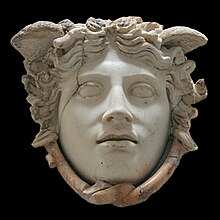Medusa Rondanini
Medusa Rondanini is the scientific name of an ancient type of Medusa head , for which the best-preserved frame was named. This head of unknown origin, executed as a high relief, was originally in the Palazzo Rondanini in Rome and was bought in 1814 by the later King Ludwig I of Bavaria from the heirs of Count Rondanini on a trip to Italy. Today the 38.8 centimeter high head made of Parian marble is under inventory number 252 in the Glyptothek in Munich .
In addition to the head from the Rondanini collection, which was probably made as a copy in the 2nd century AD, six other Roman marble copies are known. The underlying original, probably made of metal, is on the one hand with a work of classical art of the 5th century BC. BC and assigned to Phidias or an artist of his time. The main thought is the shield of Athena Parthenos , the center of which was occupied by a head of Medusa. On the other hand, it is considered whether the type is a Hellenistic model of the late 3rd or early 2nd century BC. Could repeat. Antiochus III. - or Antiochus IV. - donated according to Pausanias (1,21,3) a golden aegis with Gorgoneion in the Dionysostheater in Athens. This Gorgoneion would have been a model for the type of Medusa Rondanini according to this minor opinion .
Johann Wolfgang Goethe owned a plaster cast of his head in Rome , which he was very impressed with. On December 25, 1786, he noted in his Italian trip : "Opposite us in the Rondanini Palace is a Medusa mask, where, in a tall and beautiful face shape, over life size, the fearful stare of death is unspeakably excellently expressed." Ludwig I of Bavaria, who had acquired the Medusa Rondanini on Goethe's advice, received a new cast from Rome because Goethe had to leave his Roman one behind at the end of his journey. When Antonio Canova created the marble Perseus with the head of Medusa (1797-1801), the Medusa Rondanini served him as a model.
literature
- Ernst Buschor : Medusa Rondanini. Kohlhammer, Stuttgart 1958.
- Walter-Herwig Schuchhardt : Athena Parthenos. In: Ancient plastic. Delivery 2, 1963, p. 33f.
- Paul Zanker : Classicist statues. Studies on the change in taste in art in the Roman Empire. Philipp von Zabern, Mainz 1974 1974, p. 116.
- Josef Floren : Studies on the typology of the Gorgoneion. Aschendorff, Münster / Westf. 1977, p. 2ff. 216f.
- Barbara Vierneisel-Schlörb : Classical sculptures of the 5th and 4th centuries BC Chr. (= Staatliche Antikensammlungen und Glyptothek. Catalog of the sculptures. Volume 2). Beck, Munich 1979, 62ff. Fig. 31–35
- BJ Danforth Belson: The Medusa Rondanini. A new look. In: American Journal of Archeology . Volume 84, 1980, pp. 373-378.
- P. Callaghan: The Medusa Rondanini and Antiochus III. In: The Annual of the British School at Athens . Volume 76, 1981, pp. 59-70.
- Ingrid Krauskopf : Gorgo, Gorgones . In: Lexicon Iconographicum Mythologiae Classicae (LIMC). Volume IV, Zurich / Munich 1988, p. 329.
- Ingrid Krauskopf: The shield of the Parthenos and the type of Medusa Rondanini - Taranto, Orvieto and Athens. In: Ellen Schwinzer, Stephan Steingräber (Hrsg.): Art and culture of Magna Graecia. Your relationship to the mother country and the Italian environment. Symposium of the German Archaeological Association. Mönchengladbach 8. – 10.1.1988 (= writings of the German Archaeological Association. Volume 11). German Archaeological Association, Tübingen 1990, pp. 22–34 PDF .
- Klaus Bringmann , Hans von Steuben (Ed.): Donations from Hellenistic rulers to Greek cities and shrines. Part 1: Testimonials and Comments. Akademie Verlag, Berlin 1995, p. 53f. Cat.-No. 23.
- Johannes Rößler: In the view of Medusa Rondanini. Aporias of classical theory formation in drawings by Johann Heinrich Meyer and Friedrich Bury. In: Thorsten Valk (ed.): Tricky balances. Weimar Classics in the Process of Modernity (Series of publications by the Center for Classical Research 1). Göttingen: Wallstein, 2014, pp. 179–198.
